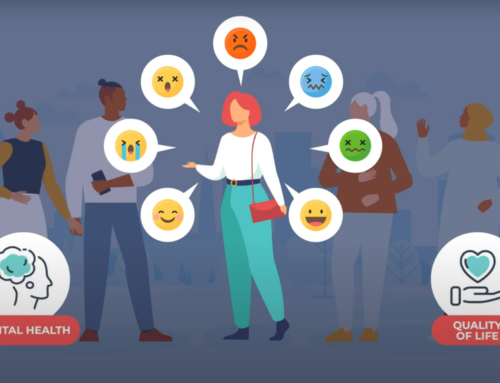Diagnosis of cancer can severely impact emotional health. Both patients and their families commonly feel psychological changes that include distress, anxiety and depression when trying to cope with diagnosis and the consequences of the disease and its treatment. With advances in early diagnosis and treatment, cancer survival rates have increased significantly, creating a large and growing population of cancer survivors with need for long-term care [1].
Indeed, it is common to feel sadness, grief, anger, worry or fear. But expressing it for a long time, particularly when there is significant impact on daily activities, demands further assessment. This can happen at different times during the course of the disease, such as following the diagnosis, during the cancer treatments or when facing unexpected changes. Therefore, it is important to recognize the psychological changes that happen during this very stressful time, and that quite often go unnoticed or are dismissed.
Both depression and anxiety are common symptoms among cancer patients, with higher prevalence rates than in the general population [2]. This happens across several points in the cancer trajectory, and both in curative and palliative treatment [3]. Evidence indicates that although common, and irrespective of known influences on quality of life, adherence to treatment, cancer survival, and treatment costs, these conditions are often neglected. In fact, depression is associated with poor adherence to cancer treatments, more frequent and longer hospitalizations, and diminished quality of life. Also, demotivation associated to depression may promote maladaptive coping styles, with a possible increase in suicidality [2]. The need for mental health care when there is suspect of depressive symptoms is thus imperative.
Symptoms worth investigating
Indications of clinical depression that should be actively investigated include the following symptoms, when occurring most of the day in most days [4]:
- Depressed mood.
- Markedly diminished interest or pleasure in all, or almost all, activities.
- Significant weight loss, weight gain, and/or decreases or increases in appetite.
- Insomnia or hypersomnia.
- A slowing down of thought and a reduction of physical movement (observable by others).
- Fatigue or loss of energy.
- Feelings of worthlessness or excessive or inappropriate guilt.
- Diminished ability to think or concentrate, or indecisiveness.
- Recurrent thoughts of death.
Different origins for the same symptom
These symptoms can be categorized as affective, cognitive or somatic, and some of them are also reported by patients with physical illnesses rather than a mental disorder. This becomes particularly challenging when diagnosing depression in the oncological setting where some symptoms can occur as cancer related symptoms, as a reaction to diagnosis and prognosis, as treatment side-effects, and/or as symptoms of depression. Additionally, some depressive and anxiety symptoms may represent a normative response when the patient confronts repeated threats to life, is under cancer treatments, or is experiencing pain.
For instance, crying or feelings of sadness may be a normative response in the context of disease, may represent a symptom of depression, or maybe both. Similarly, a decrease in appetite may be a side effect of cancer treatments, a symptom of depression, or both. Thus, the risk of misclassifying symptoms of depression as cancer related symptoms, or vice-versa, highlights the need of a comprehensive evaluation.
Recognizing the right causes
Some of the barriers to detect depression in patients with cancer include lack of time to fully assess depression in busy oncological settings, but also unfamiliarity with the assessment methods and the lack of specific skills to diagnose psychiatric disorders. Therefore, the use of proper screening instruments could facilitate the recognition of affective disorders in the oncological setting so to refer the identified individuals to psychological or psychiatric care. Those instruments should be easy to administer and score, acceptable to patients, validated to the oncological population and, importantly, accurate [5]. Indeed, early detection and adequate treating and monitoring of these psychological disorders is crucial to reduce their well-known negative consequences in patients with cancer, and to promote improved quality of life and ensure adequate post-cancer support.
Authors: Sílvia Almeida, Raquel Lemos and Albino J. Oliveira-Maia of the Champalimaud Research and Clinical Centre – Champalimaud Centre for the Unknown (Lisbon, Portugal).
Sources:
[1] Siegel, R. L., Miller, K. D., & Jemal, A. (2020). Cancer statistics, 2020. CA: a cancer journal for clinicians, 70(1), 7–30. https://doi.org/10.3322/caac.21590
[2] Pitman, A., Suleman, S., Hyde, N., & Hodgkiss, A. (2018). Depression and anxiety in patients with cancer. BMJ (Clinical research ed.), 361, k1415. https://doi.org/10.1136/bmj.k1415
[3] Mitchell, A. J., Chan, M., Bhatti, H., Halton, M., Grassi, L., Johansen, C., & Meader, N. (2011). Prevalence of depression, anxiety, and adjustment disorder in oncological, haematological, and palliative-care settings: a meta-analysis of 94 interview-based studies. The Lancet. Oncology, 12(2), 160–174. https://doi.org/10.1016/S1470-2045(11)70002-X
[4] American Psychiatric Association. (2013). Major Depressive Disorder. In Diagnostic and statistical manual of mental disorders (5th ed.).
[5] Andersen, B. L., DeRubeis, R. J., Berman, B. S., Gruman, J., Champion, V. L., Massie, M. J., … & Rowland, J. H. (2014). Screening, assessment, and care of anxiety and depressive symptoms in adults with cancer: an American Society of Clinical Oncology guideline adaptation. Journal of Clinical Oncology, 32(15), 1605.




